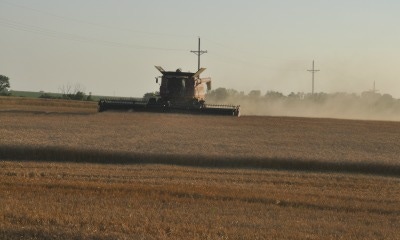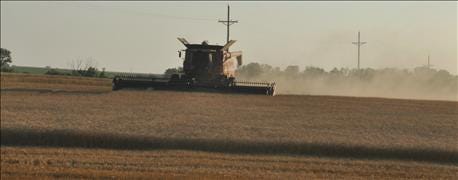
The 2015 Kansas hard red winter wheat crop is slowly moving into history.
After about 10 days of harvest that have translated to about six days of actual cutting, farmers in areas skipped by widespread rains are done with harvest, while those in regions repeatedly drenched are still struggling through the wet spots.
As harvest moves northward, however, the news continues to be better than expected when the bushels are counted -- provided of course, you were not unlucky enough to be hit by tennis ball to softball size hail.

HARVEST ROLLING: Combines continue to roll in areas not hit by scattered thunderstorms, with harvest nearing the halfway point to completion over the weekend.
In Lane County, Ron Suppes says he expected to get 12 to 15 bushels to the acre in April. He is harvesting more like 40 bushels except for those areas hit by hail, which have been cut to 15 to 20 bushels to the acre.
Because western Kansas has missed the most recent rains, Suppes says his test weights are still at 62 pounds.
In southeast Kansas, farmers were again keeping an eye on the sky as the weekend wound down with severe storms, high winds, heavy rains and hail that mean more delays to harvest.
South central Kansas was pushing toward completion of harvest over the weekend, with most farmers expecting to be done before the July 4 holiday as long as there isn't more rain.
Across southern Kansas, yields have been much better than predicted in April, ranging from 30 bushels to 70 bushels to the acre. The biggest issue has been test weights, which have dropped with the persistent rain, dropping as low as 57 to 58 pounds per bushel in hard-hit areas.
Disease has played a role in lowering test weights as well. Blake Connely from the Southern Plains Coop in Lewis in Edwards County, told the authors of the Kansas Wheat Harvest Report, that fields that weren't sprayed for disease area averaging test weights from 55 to 58 pounds, while those that were sprayed are weighing in at 60- to 64 pounds.
His area is averaging yields between 40-50 bushels an acre.
Protein across the state is averaging about 12% with some fields in high-stress areas coming in higher.
About the Author(s)
You May Also Like






